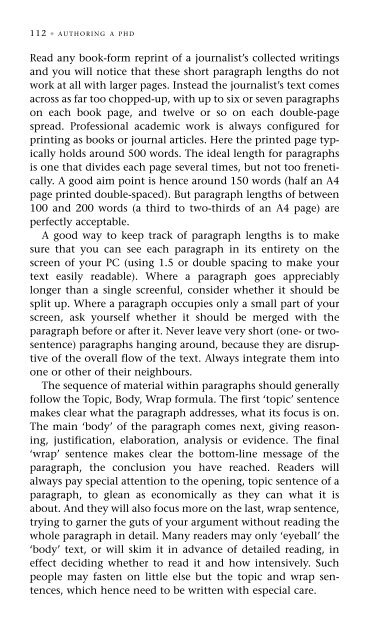How to plan, draft, write and finish a doctoral thesis or dissertation
How to plan, draft, write and finish a doctoral thesis or dissertation
How to plan, draft, write and finish a doctoral thesis or dissertation
You also want an ePaper? Increase the reach of your titles
YUMPU automatically turns print PDFs into web optimized ePapers that Google loves.
112 ◆ AUTHORING A PHD<br />
Read any book-f<strong>or</strong>m reprint of a journalist’s collected writings<br />
<strong>and</strong> you will notice that these sh<strong>or</strong>t paragraph lengths do not<br />
w<strong>or</strong>k at all with larger pages. Instead the journalist’s text comes<br />
across as far <strong>to</strong>o chopped-up, with up <strong>to</strong> six <strong>or</strong> seven paragraphs<br />
on each book page, <strong>and</strong> twelve <strong>or</strong> so on each double-page<br />
spread. Professional academic w<strong>or</strong>k is always configured f<strong>or</strong><br />
printing as books <strong>or</strong> journal articles. Here the printed page typically<br />
holds around 500 w<strong>or</strong>ds. The ideal length f<strong>or</strong> paragraphs<br />
is one that divides each page several times, but not <strong>to</strong>o frenetically.<br />
A good aim point is hence around 150 w<strong>or</strong>ds (half an A4<br />
page printed double-spaced). But paragraph lengths of between<br />
100 <strong>and</strong> 200 w<strong>or</strong>ds (a third <strong>to</strong> two-thirds of an A4 page) are<br />
perfectly acceptable.<br />
A good way <strong>to</strong> keep track of paragraph lengths is <strong>to</strong> make<br />
sure that you can see each paragraph in its entirety on the<br />
screen of your PC (using 1.5 <strong>or</strong> double spacing <strong>to</strong> make your<br />
text easily readable). Where a paragraph goes appreciably<br />
longer than a single screenful, consider whether it should be<br />
split up. Where a paragraph occupies only a small part of your<br />
screen, ask yourself whether it should be merged with the<br />
paragraph bef<strong>or</strong>e <strong>or</strong> after it. Never leave very sh<strong>or</strong>t (one- <strong>or</strong> twosentence)<br />
paragraphs hanging around, because they are disruptive<br />
of the overall flow of the text. Always integrate them in<strong>to</strong><br />
one <strong>or</strong> other of their neighbours.<br />
The sequence of material within paragraphs should generally<br />
follow the Topic, Body, Wrap f<strong>or</strong>mula. The first ‘<strong>to</strong>pic’ sentence<br />
makes clear what the paragraph addresses, what its focus is on.<br />
The main ‘body’ of the paragraph comes next, giving reasoning,<br />
justification, elab<strong>or</strong>ation, analysis <strong>or</strong> evidence. The final<br />
‘wrap’ sentence makes clear the bot<strong>to</strong>m-line message of the<br />
paragraph, the conclusion you have reached. Readers will<br />
always pay special attention <strong>to</strong> the opening, <strong>to</strong>pic sentence of a<br />
paragraph, <strong>to</strong> glean as economically as they can what it is<br />
about. And they will also focus m<strong>or</strong>e on the last, wrap sentence,<br />
trying <strong>to</strong> garner the guts of your argument without reading the<br />
whole paragraph in detail. Many readers may only ‘eyeball’ the<br />
‘body’ text, <strong>or</strong> will skim it in advance of detailed reading, in<br />
effect deciding whether <strong>to</strong> read it <strong>and</strong> how intensively. Such<br />
people may fasten on little else but the <strong>to</strong>pic <strong>and</strong> wrap sentences,<br />
which hence need <strong>to</strong> be written with especial care.


